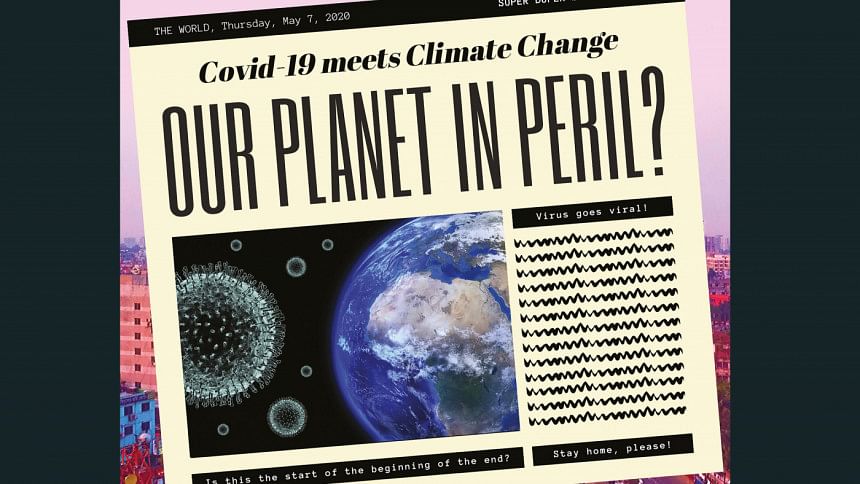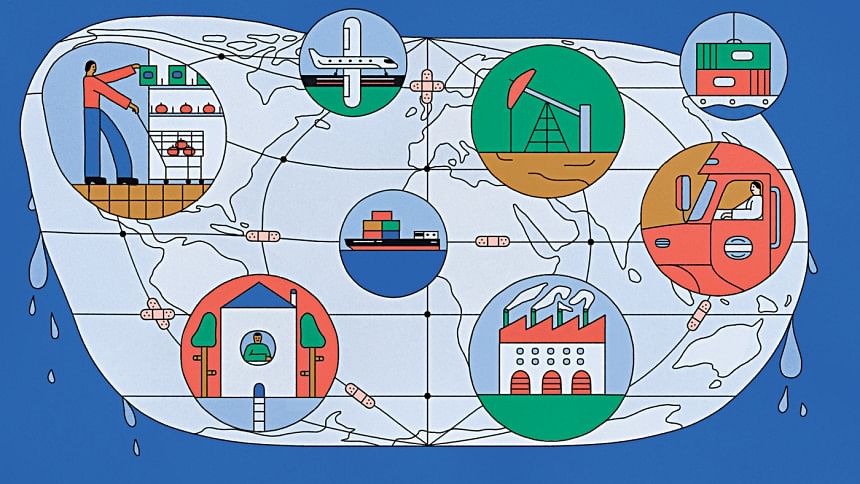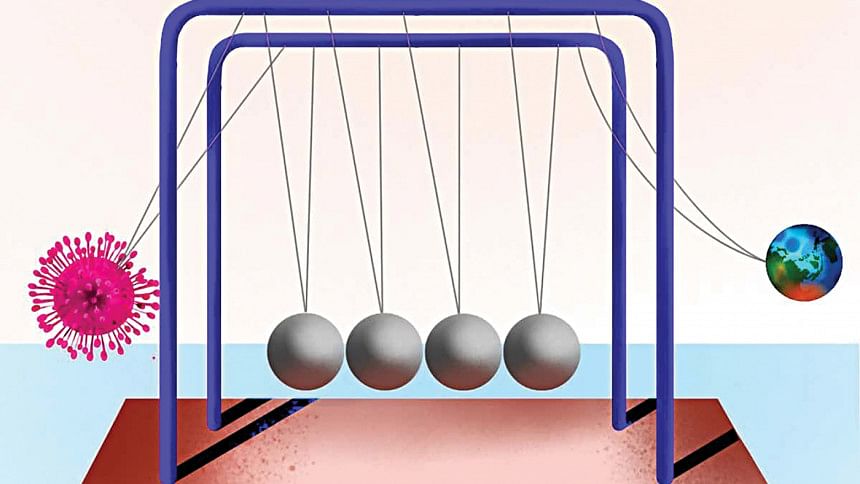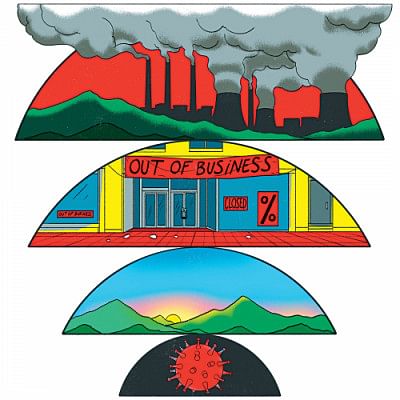OUR PLANET IN PERIL?

Ever since the onset of the Covid-19 crisis, horrifying news has become an overwhelming yet regular part of our lives. Somewhere in the devastating revelations about present circumstances and the days that await in the future, people have been looking for good news like a drowning person, gasping for air. And so, positive news such as the one about dolphins seen around certain coasts after years took social media by a storm. Masked with a sense of pride for somehow having saved the planet with shares and the new "care" reacts, we are avoiding some crucial conversations.
THE POSSIBLE RELATIONSHIP BETWEEN CLIMATE CHANGE AND PANDEMICS
While the whole situation is as unprecedented as it seems, it has been in the making for a long time. Seventy-five percent of all emerging, or novel, viruses are "zoonotic", meaning they come from animals. These viruses tend to stay dormant in their natural reservoir without causing diseases, until they reactivate, and possibly mutate, moving to a host with a similar strain through direct exposure. Human intervention, in the form of deforestation or urbanisation, forces animal carriers to move to new areas. This increases the probability of human contact, making us the presumptive new host (Madigan, Martinko, Bender, Buckley & Stahl, 2015).

Additionally, changing global climate patterns which are not only limited to extreme weather conditions, can cause changes to the seasonality and geography of many diseases as their vectors move in search of new territory. Malaria, for example, is predicted to shift northwards, becoming more prevalent in regions of Europe and the United States. Studies show that at least 49 percent of the world will be at risk of mosquito-borne disease by the year 2050, with this percentage expected to rise as temperatures increase and conditions dampen. Rising sea levels, on the other hand, expose millions to lowered levels of water security, leading to more occurrences of water-borne diseases caused by bacteria, viruses and parasites, as well as infections caused by contact with contaminated water.
Meanwhile, as global temperatures rise and the Arctic ice melts, there may be yet another cause for major concern. Ice holds millennia of history in each of its layers, and unsurprisingly, much of it is inanimate. What may be a cause of concern are the parts that can be reanimated: the viruses. While scientists believe these organisms would not survive outside laboratories, these menaces are armed with the ability to evolve, and that is as powerful as any weapon can get.
Take the 2016 anthrax outbreak for example. Over 70 nomadic herders including 41 children were infected, causing one death—by the Siberian Plague—not seen in the region since 1941. Anthrax spores, released by the thawing ice, had infected reindeer en masse, and then infected humans. This raises the question: what if diseases such as smallpox and the plague re-emerge as well? One argument would be that the risk is small. The DNA from these organisms are in fragments, and unlikely to infect humans. On the other hand, the risk is unknowable, but there is a non-zero possibility of whatever thawing out of the permafrost potentially triggering another pandemic (Fox-Skelly, 2017).
THE IMPACT OF THE LOCKDOWN ON THE ENVIRONMENT
Countries all over the world have been in a complete lockdown or shutdown since about mid-March, or even earlier for some. This meant that a closure was imposed on all sorts of movements and industrial activity. As a result, air pollution levels drastically dropped all over the world. Europe, for example, has seen a 40 percent decrease in NO2 levels and 10 percent decrease in PM2.5 (atmospheric particulate matter that has a diameter of less than 2.5 micrometer) (Watts, 2020).
The changes aren't just observable overseas, Bangladesh too has experienced visible changes in its air quality. According to the data provided by the World Health Organization (WHO), the air quality in Dhaka reaches an annual average of 90 µg/m3 of PM2.5, which corresponds to a value of 168 in the Air Quality Index (AQI), categorised as "unhealthy". This is only the average, meaning that on particular days, the levels reach values above 300, reaching stages marked as being "hazardous". Recently, however, the numbers have been much lower than the average.
Even though this might sound like good news, the first thing for us to consider is if the changes are sustainable. Such drastic changes have only been possible because the world is facing a deadly situation that has caused factories to largely discontinue their activities and traffic filled roads to be as close to being deserted as possible, substantially cutting down pollution and reducing emissions by a huge percentage. The International Monetary Fund (IMF) says that the world is led to face "the worst economic downturn since the Great Depression" (Gopinath, 2020) and if history is of any reference it can be said that a major boom of emission awaits after a recession.
Not only that, an analysis based on the most recent figures available, initially published in mid February and updated on March 30 by the website Carbon Brief shows that even though China's emissions had plummeted by 25 percent over a four week period starting February 3, but as they begin to emerge from the crisis, the emissions have slowly started to increase once again in about the next seven weeks (Myllyvirta, 2020).

PROTECTING THE ENVIRONMENT COULD HELP SAVE US
Due to the pandemic, oil prices have reached a new record low. With a sudden and rapid drop in the demand leading to sinking prices, the oil industry is facing significant threats. Not only that, it is also being predicted by the International Energy Agency (IEA) that the pandemic could trigger an even further decrease in the consumption of fuel (Ambrose, 2020). Thus, like for any other situation, the next point of consideration would be to find alternatives.
Renewable and clean energy sources have been suggested numerous times as alternatives to fossil fuel but it has been widely rejected as the process to shift from one form of energy to the other is said to be "too disruptive." Now that the shutdowns have already caused a disruption beyond anyone's imagination, this may be the right time to make the switch.
According to an article published on April 20 by British newspaper The Guardian, switching to renewable energy sources could drive Covid-19 recovery with almost USD 80 trillion boost (Ambrose, 2020). The article refers to a report by the The International Renewable Energy Agency which says that by the year 2050, not only would the global GDP shoot up by almost USD 100 trillion, it could create more jobs and help reduce about 70 percent of the energy industry's carbon dioxide emissions.

Thus, not only will we be solving the economic issues that lie ahead of us, we will also be taking a much required step to combat global warming and the climate crisis. However, the question remains, will we actually do it?
We can draw parallels between the present and the pre-emptive. The link between global warming and Covid-19, seemingly inconspicuous at first, is more than a mere coincidence. Both are issues we cannot ignore just because they aren't convenient for us. Years of unheeded warnings of climate change causing the same level of global disruption, if not worse, yet we did not feel the need to change our routines for a threat we could not see. People are dying; all we see are rising digits.
Currently, it is extremely difficult to predict what will happen in the future for two main reasons. First, we do not know how long it will take for things to go back to normal; secondly, the policies made and steps taken by countries to combat the economic downfall are subjective in nature. The cut in pollution and emissions over hundreds of thousands of deaths is not a matter to be celebrated. However, an important takeaway from all of this would be to consider a systematic approach that would protect both the planet and its population.
References
1. Ambrose, J. (2020, April 30). Covid-19 crisis will wipe out demand for fossil fuels, says IEA. Retrieved from The Guardian: https://www.theguardian.com/business/2020/apr/30/covid-19-crisis-demand-fossil-fuels-iea-renewable-electricity
2. Ambrose, J. (2020, April 20). Green energy could drive Covid-19 recovery with $100tn boost. Retrieved from The Guardian: https://www.theguardian.com/environment/2020/apr/20/green-energy-could-drive-covid-19-recovery-international-renewable-energy-agency
3. Fox-Skelly, J. (2017, May 4). There are diseases hidden in ice, and they are waking up. Retrieved from BBC: http://www.bbc.com/earth/story/20170504-there-are-diseases-hidden-in-ice-and-they-are-waking-up
4. Gopinath, G. (2020, April 14). The Great Lockdown: Worst Economic Downturn Since the Great Depression. Retrieved from IMF Blog: https://blogs.imf.org/2020/04/14/the-great-lockdown-worst-economic-downturn-since-the-great-depression
5. Madigan, Martinko, Bender, Buckley & Stahl. (2015). Brock Biology of Microorganisms. Pearson Education Limited.
6. Myllyvirta, L. (2020, April 19). Analysis: Coronavirus temporarily reduced China's CO2 emissions by a quarter. Retrieved from Carbon Brief: https://www.carbonbrief.org/analysis-coronavirus-has-temporarily-reduced-chinas-co2-emissions-by-a-quarter
7. Watts, J. (2020, April 30). Clean air in Europe during lockdown leads to 11,000 fewer deaths. Retrieved from The Guardian: https://www.theguardian.com/environment/2020/apr/30/clean-air-in-europe-during-lockdown-leads-to-11000-fewer-deaths

 For all latest news, follow The Daily Star's Google News channel.
For all latest news, follow The Daily Star's Google News channel. 



Comments